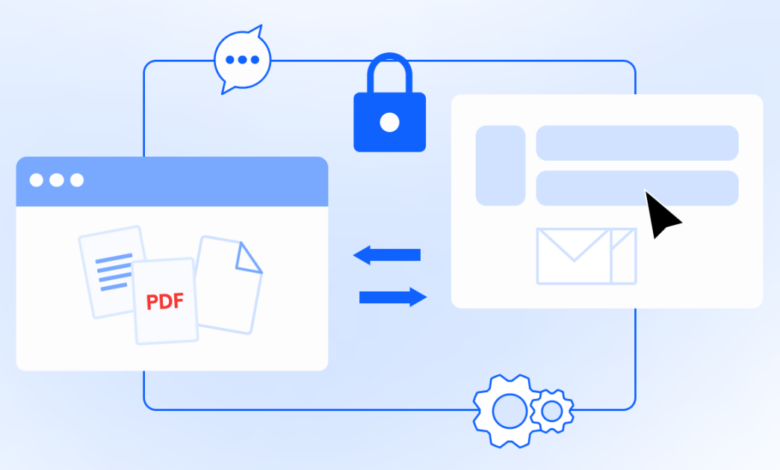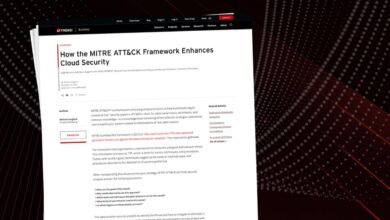
How B2B Brands Secure Data Protection
How B2B brands can employ cybersecurity for data protection is crucial in today’s digital landscape. From financial records to sensitive customer information and valuable intellectual property, safeguarding data is paramount. This exploration delves into the critical strategies businesses need to implement robust security measures, protect sensitive data, and maintain compliance with evolving regulations.
B2B cybersecurity encompasses a wide range of measures, from employee training and strong passwords to advanced encryption techniques and third-party risk assessments. This in-depth guide will equip you with the knowledge and tools necessary to navigate the complexities of data protection in the modern business world. Understanding the risks and implementing appropriate controls is vital for maintaining a secure and compliant environment.
Introduction to B2B Cybersecurity
B2B cybersecurity is the practice of protecting sensitive information and systems used by businesses in their interactions with other businesses. It’s a critical component of operational efficiency and trust in the modern business landscape. This encompasses not only the digital realm but also physical security measures that protect data and assets.Data protection is paramount for B2B brands because it directly impacts their reputation, financial stability, and operational continuity.
A breach can lead to significant financial losses, legal repercussions, and damage to the brand’s trustworthiness. Maintaining a robust cybersecurity posture builds confidence with partners, investors, and customers.
Types of Data Handled by B2B Companies
B2B companies handle a variety of sensitive data crucial to their operations. Understanding these data types is essential to implementing effective protection strategies.
- Financial Data: This includes bank account details, transaction records, payment processing information, and financial statements. Protecting this data prevents fraud, theft, and financial loss.
- Customer Data: B2B companies often hold extensive information about their clients, such as contact details, purchase history, and preferences. Protecting this data builds trust and ensures compliance with privacy regulations.
- Intellectual Property (IP): This encompasses trade secrets, patents, copyrights, and other proprietary information. Safeguarding IP is vital for maintaining a competitive edge and preventing unauthorized use.
- Operational Data: Internal business processes, production plans, supply chain details, and other operational information are vital to a company’s success. Security breaches can disrupt workflows and compromise strategic plans.
Potential Risks to B2B Data
Data breaches and other security incidents pose significant threats to B2B companies. Understanding these risks is the first step toward mitigating them.
B2B brands need robust cybersecurity measures to safeguard sensitive data. This includes multi-layered security protocols and regular security audits. Recent developments like the Department of Justice Offers Safe Harbor for MA Transactions ( Department of Justice Offers Safe Harbor for MA Transactions ) highlight the growing importance of compliance and risk management. Ultimately, these measures ensure that your company’s data remains secure, fostering trust with clients and maintaining a strong reputation.
| Risk Type | Description | Impact |
|---|---|---|
| Phishing Attacks | Deceptive emails or websites designed to trick employees into revealing sensitive information, such as usernames, passwords, or credit card details. | Financial loss, data breaches, reputational damage. For example, a successful phishing attack could compromise access to sensitive financial records, resulting in significant financial loss for the targeted company. |
| Malware Infections | Malicious software that can infiltrate systems, steal data, disrupt operations, or grant unauthorized access. | Data breaches, operational disruption, financial losses, reputational damage. For example, ransomware attacks can encrypt critical data, demanding payment for its release, resulting in significant downtime and potential financial losses. |
| Insider Threats | Employees who intentionally or unintentionally compromise security, either through malicious intent or negligence. | Data breaches, financial losses, reputational damage. A disgruntled employee with access to sensitive data could cause significant harm. |
| Data Breaches | Unauthorized access or disclosure of sensitive data. | Financial loss, legal repercussions, reputational damage, loss of customer trust. For example, a breach of customer credit card data can result in significant financial penalties and loss of customer trust. |
Implementing Robust Security Measures

Protecting sensitive business data in the B2B world requires a multi-layered approach to cybersecurity. A strong security posture isn’t just about installing software; it’s about integrating security controls into every aspect of your operations, from employee onboarding to data handling procedures. This proactive approach significantly reduces the risk of breaches and safeguards your company’s reputation and financial stability.
Key Security Controls for Data Protection, How b2b brands can employ cybersecurity for data protection
Robust security controls are essential for safeguarding sensitive B2B data. These controls encompass a range of measures, from network security to access management, ensuring data remains confidential, available, and integral. Implementing these controls is a critical step in building a strong security posture. A comprehensive approach that incorporates these measures significantly reduces the likelihood of successful attacks.
Multi-Factor Authentication (MFA)
Multi-factor authentication adds an extra layer of security beyond traditional usernames and passwords. This involves requiring users to provide multiple verification methods, such as a code sent to their phone or a biometric scan, before accessing sensitive information. By requiring more than one form of verification, MFA significantly increases the difficulty for unauthorized individuals to gain access. This significantly enhances security by making it harder for attackers to gain access, even if they have stolen or guessed a password.
For example, a financial institution using MFA would require a user to enter their password, then a code sent to their registered mobile phone before accessing account information.
Strong Password Policies and Procedures
Implementing and enforcing strong password policies is a fundamental aspect of cybersecurity. These policies should mandate the use of complex passwords, ideally including a mix of uppercase and lowercase letters, numbers, and symbols. Regular password changes, and strong password managers, should be encouraged. Enforcing password complexity significantly reduces the risk of easily cracked passwords, a frequent vulnerability in many data breaches.
For example, a company could implement a policy requiring employees to change their passwords every 90 days and using a password manager to generate strong, unique passwords for each account.
Access Control Methods
Implementing proper access controls is critical for preventing unauthorized access to sensitive data. A well-defined access control system ensures that only authorized individuals can access specific data or resources. This is crucial for maintaining data integrity and compliance with regulations.
| Method | Description | Advantages | Disadvantages |
|---|---|---|---|
| Role-Based Access Control (RBAC) | Access rights are assigned based on the user’s job role. | Efficient for managing access across large groups of users, simplifies administration, and reduces the risk of human error. | Can be inflexible for specific user needs, potential for over-privileged access if roles are not carefully defined. |
| Attribute-Based Access Control (ABAC) | Access rights are determined based on various attributes (e.g., user location, time of day, device type). | Highly flexible, allowing for fine-grained control over access based on specific attributes. | Complex to implement and manage, requiring careful definition of attributes and their relationships to access rights. |
| Rule-Based Access Control (RBAC) | Access rights are determined by predefined rules. | Provides consistent and predictable access policies, easy to maintain and audit. | Can be less flexible compared to ABAC. Difficult to adapt to evolving security needs. |
Data Encryption and Protection Strategies: How B2b Brands Can Employ Cybersecurity For Data Protection
Protecting sensitive B2B data is paramount in today’s digital landscape. Robust encryption methods, secure storage, and secure transmission protocols are crucial components of a comprehensive cybersecurity strategy. Implementing these safeguards not only mitigates risks but also fosters trust with clients and partners, ultimately enhancing your brand’s reputation.
Different Data Encryption Methods
Various encryption methods exist, each with its own strengths and weaknesses. Understanding these differences allows businesses to choose the most suitable approach for their specific data needs. Symmetric-key encryption, using the same key for encryption and decryption, is faster but requires secure key management. Asymmetric-key encryption, employing separate keys for encryption and decryption, ensures greater security but can be slower.
Hashing algorithms create unique fingerprints of data, crucial for integrity verification, but don’t offer the ability to decrypt the data itself.
Secure Storage Solutions
Secure storage solutions are essential for protecting sensitive data at rest. These solutions encompass various approaches, from dedicated hardware security modules (HSMs) to cloud storage services with advanced encryption features. Properly configured and regularly audited storage systems form a critical part of the overall security architecture. Data loss prevention (DLP) tools can be integrated to prevent unauthorized data access and exfiltration.
The choice of storage solution should consider the volume and sensitivity of the data, as well as regulatory compliance requirements.
Data Protection During Transmission
Protecting data during transmission is equally critical. Encryption protocols, like TLS/SSL, are essential for securing communication channels. These protocols encrypt data transmitted over networks, preventing unauthorized access. Virtual private networks (VPNs) create secure tunnels over public networks, ensuring confidentiality and integrity during data transfer. Multi-factor authentication (MFA) adds an extra layer of security, requiring multiple verification steps for access to sensitive data.
Data Backup and Recovery Solutions
Data backups and recovery solutions are crucial for disaster preparedness and business continuity. A comprehensive backup strategy protects against data loss due to various threats, such as hardware failures, cyberattacks, or natural disasters. Different solutions cater to various needs and budgets. Consider the recovery time objective (RTO) and recovery point objective (RPO) when selecting a solution.
| Solution | Features | Cost |
|---|---|---|
| Cloud-based Backup | Scalability, accessibility from anywhere, often with automated backups. | Typically subscription-based, cost varies with storage needs. |
| On-premises Backup | Greater control over infrastructure, potential for customization. | Higher upfront investment, ongoing maintenance costs. |
| Hybrid Backup | Combines cloud and on-premises solutions for flexibility and cost optimization. | Cost depends on the specific configuration and features. |
Employee Training and Awareness
A strong cybersecurity posture isn’t just about technology; it’s fundamentally about people. Employee training and awareness programs are critical to mitigating risks, as human error often represents the weakest link in any security system. Educating employees about potential threats and best practices fosters a culture of security vigilance, dramatically reducing the likelihood of successful attacks.Employee training isn’t a one-time event but an ongoing process that adapts to evolving threats and company practices.
Regular refreshers and new training modules keep employees informed about the latest scams and techniques. A culture of security, where employees feel empowered to report suspicious activity, is paramount.
Importance of Employee Training Programs
Employee training programs are vital for building a strong security culture. They equip employees with the knowledge and skills to identify and report potential threats, significantly reducing the risk of data breaches. Proactive training fosters a sense of shared responsibility for protecting sensitive company information. It also helps establish clear expectations and procedures for handling security incidents.
Examples of Phishing Scams and Social Engineering Tactics
Phishing scams, often delivered via email, aim to trick employees into revealing sensitive information like passwords or credit card details. These scams frequently mimic legitimate organizations, using logos and branding to increase their credibility. Social engineering tactics manipulate human psychology to gain access to information. These tactics leverage trust and authority, often impersonating managers or colleagues.Examples of phishing scams include emails claiming to be from a bank or payment provider requesting urgent account verification.
Social engineering tactics may involve a seemingly harmless request from a colleague for a file or login credentials. Sophisticated phishing campaigns may even use AI to personalize messages, increasing their effectiveness.
Methods for Identifying and Reporting Security Threats
Identifying security threats requires a combination of vigilance and established reporting procedures. Employees should be trained to look for suspicious emails, unusual website requests, or any communication that seems out of the ordinary. Red flags include grammatical errors, poor formatting, or requests for unusual information.Establishing clear reporting channels is essential. A dedicated email address, a secure online portal, or a designated security hotline can help employees report potential threats without fear of reprisal.
Training should cover the steps for reporting these threats, ensuring a swift and effective response.
B2B brands need robust cybersecurity measures to protect sensitive data. One crucial step is implementing advanced code security tools, like those discussed in Deploying AI Code Safety Goggles Needed. By proactively addressing vulnerabilities in software development, businesses can significantly reduce the risk of breaches and maintain customer trust. This proactive approach is key to a comprehensive data protection strategy.
Best Practices for Creating a Secure Company Culture
Creating a secure company culture requires a proactive approach that goes beyond technical measures. Encouraging a “think before you click” mentality fosters a security-conscious environment. Open communication about security risks, successes, and vulnerabilities builds trust and transparency.Transparency and open communication should extend to the methods used to address security breaches and the consequences of improper actions. Regular security awareness campaigns, emphasizing the importance of vigilance and the potential consequences of a data breach, are also critical.
Rewards for reporting security incidents and sanctions for malicious activity can be incorporated into policies to further incentivize the reporting of potential threats.
Third-Party Risk Management
Protecting your business data isn’t just about your internal systems. A crucial aspect often overlooked is the security posture of your third-party vendors. They hold access to your sensitive information, and a lapse in their security can compromise your entire operation. This section dives deep into the significance of evaluating third-party security practices, providing a practical framework for assessing vendors and mitigating potential vulnerabilities.
Evaluating Third-Party Security Practices
Third-party vendors often handle sensitive data on your behalf, making their security practices a direct extension of your own. Neglecting to assess these practices can expose your organization to significant risks. This evaluation isn’t a one-time check; it’s an ongoing process, crucial for maintaining a robust security posture. Regular audits and updates are essential as vendor security procedures evolve.
Assessing Vendor Security Posture
A comprehensive assessment of a vendor’s security posture requires a multi-faceted approach. This involves reviewing their security policies, incident response plans, and technical controls. Look for certifications, such as ISO 27001, to validate their commitment to robust security measures. Thorough due diligence extends beyond their documented policies; consider observing their operational security practices. This could involve checking their physical security measures, access controls, and employee training programs.
Scrutinize their technical infrastructure for vulnerabilities and ensure they comply with relevant regulations. This rigorous evaluation helps in identifying any weaknesses or gaps in their security measures.
Potential Vulnerabilities Introduced by Third-Party Access
Third-party access to your data introduces various potential vulnerabilities. A vendor’s compromised security can lead to data breaches, exposing confidential customer information, intellectual property, or financial records. Phishing attacks targeting your vendors can gain access to your systems through compromised accounts. Insufficient access controls within the vendor’s systems can allow unauthorized personnel to view or modify sensitive data.
Software vulnerabilities in vendor applications can also be exploited, creating backdoors into your network. These vulnerabilities highlight the critical importance of stringent third-party risk management procedures.
Managing Third-Party Risk
A proactive approach to third-party risk management is crucial. A well-defined process minimizes the impact of potential security breaches. Following a structured approach helps you stay ahead of emerging threats.
| Step | Description | Timeline |
|---|---|---|
| 1. Identification | Identify all third-party vendors with access to sensitive data. Document their roles and responsibilities. | Ongoing, during vendor onboarding |
| 2. Assessment | Evaluate the vendor’s security posture through questionnaires, audits, and security assessments. Consider their security policies, technical controls, and incident response plans. | Pre-contract or during contract renewal |
| 3. Mitigation | Develop and implement mitigation strategies to address any identified vulnerabilities. This may include security requirements in contracts, regular audits, or enhanced security measures for the vendor’s access. | Ongoing, aligned with vendor agreements and audit cycles |
| 4. Monitoring | Continuously monitor the vendor’s security posture to detect and respond to emerging threats. Stay informed about industry best practices and emerging vulnerabilities. | Ongoing, during vendor contracts |
Incident Response Planning
A robust cybersecurity posture isn’t just about prevention; it’s equally crucial to have a well-defined plan for responding to security incidents. A comprehensive incident response plan (IRP) acts as a roadmap for your organization to effectively handle a security breach, minimizing damage and restoring operations as quickly as possible. Having a pre-defined strategy is paramount, allowing your team to react calmly and methodically during a crisis, rather than scrambling in panic.A well-structured incident response plan isn’t a one-size-fits-all document.
It needs to be tailored to your specific business needs, considering factors like the type of data you handle, the size of your organization, and your industry regulations. This plan should detail every crucial step, from initial detection to containment and recovery.
Importance of an Incident Response Plan
A well-developed incident response plan is essential for mitigating the impact of security breaches. It Artikels clear roles and responsibilities for different personnel, enabling efficient and coordinated actions during a security incident. This structured approach ensures a swift and effective response, reducing potential damage and ensuring business continuity.
Steps to Take in Case of a Security Breach
A security incident response plan should include clear steps to follow when a breach occurs. The process should be practiced and updated regularly to ensure its efficacy. The steps typically include:
- Detection and Analysis: Immediately identify the breach, assess the scope of the damage, and determine the nature of the threat. Tools like intrusion detection systems (IDS) and security information and event management (SIEM) systems play a vital role in early detection. A meticulous log review is also critical.
- Containment: Isolate the compromised systems or data to prevent further spread of the incident. This often involves shutting down affected networks or applications. This action is crucial to contain the breach and prevent any further damage to the organization’s systems.
- Eradication: Remove the threat from the environment. This involves remediation activities, such as fixing vulnerabilities, patching systems, or restoring data from backups. The goal is to eliminate the root cause of the breach.
- Recovery: Restore systems and data to their pre-incident state. This includes implementing recovery procedures from backups, restoring configurations, and ensuring data integrity. This phase ensures the organization is back to normal operation.
- Post-Incident Analysis: Thoroughly analyze the incident to identify areas for improvement in security measures and the incident response plan itself. This step is crucial for learning from mistakes and preventing similar incidents in the future.
Effective Communication During a Security Incident
Clear and timely communication is vital during a security incident. A dedicated communication channel should be established to keep stakeholders informed about the situation and response progress. This includes:
- Internal Communication: Keeping employees informed about the incident and their roles in the response process.
- External Communication: Informing customers, partners, and regulatory bodies about the incident and the organization’s response, adhering to any legal or regulatory requirements.
Examples of Effective Incident Response Procedures
Effective incident response procedures are demonstrably vital for a B2B brand. They need to be well-defined, practiced, and regularly updated to maintain effectiveness. An example is a real-world scenario:
- Phishing Attack Response: If a phishing campaign targets employees, the IRP should Artikel the steps to take to contain the spread, mitigate the damage, and ensure employee safety. This includes immediately disabling compromised accounts and providing training on phishing awareness.
- Data Breach Response: In a data breach, the plan should specify how to contain the breach, notify affected individuals, and ensure compliance with data privacy regulations. For instance, a company might need to notify customers about a compromised database and implement measures to secure their data.
Compliance and Regulations
Navigating the complex world of cybersecurity for B2B brands often involves understanding and adhering to specific regulations. These regulations, designed to protect sensitive data and ensure responsible practices, are not just good to have; they are crucial for maintaining trust with customers and partners, avoiding legal repercussions, and ultimately, safeguarding your business’s reputation. Compliance demonstrates a commitment to data security, bolstering your brand’s image and fostering stronger relationships.Compliance with cybersecurity regulations isn’t just a legal obligation; it’s a strategic imperative for B2B success.
Demonstrating a commitment to data protection builds trust with clients and partners, fostering stronger relationships and promoting long-term business growth. Conversely, non-compliance can result in substantial financial penalties and damage to your brand’s reputation. Understanding the regulations and implementing the necessary measures for compliance is a proactive step towards building a resilient and trustworthy organization.
Relevant Cybersecurity Regulations
B2B brands must familiarize themselves with various regulations that govern data protection, such as the General Data Protection Regulation (GDPR) and the California Consumer Privacy Act (CCPA). Understanding these regulations, as well as other relevant laws specific to their industry, is paramount. This involves analyzing the scope of each regulation to determine its applicability to their business operations.
B2B brands need robust cybersecurity measures to protect their sensitive data. A recent vulnerability in Microsoft Azure Cosmos DB, detailed in Azure Cosmos DB Vulnerability Details , highlights the critical need for ongoing security assessments. Understanding these vulnerabilities is key to building comprehensive data protection strategies and implementing the necessary security protocols to prevent similar breaches. Implementing multi-factor authentication, regularly updating software, and conducting thorough security audits are just a few ways B2B companies can strengthen their defenses.
Importance of Compliance for B2B Brands
Compliance with cybersecurity regulations is essential for B2B brands for several reasons. Firstly, it fosters trust and confidence among customers and partners. Secondly, compliance demonstrates a proactive approach to data protection, mitigating the risk of security breaches and associated financial losses. Furthermore, compliance demonstrates a commitment to ethical data handling, which is vital for maintaining a positive brand image.
This commitment to data security builds trust, enabling long-term business relationships.
Potential Penalties for Non-Compliance
Non-compliance with cybersecurity regulations can result in significant penalties, ranging from hefty fines to legal repercussions. For example, violations of GDPR can lead to substantial financial penalties, potentially impacting a company’s profitability and operational stability. These penalties are not only financial; they can also result in reputational damage, impacting customer trust and potentially leading to significant business disruption.
Furthermore, in severe cases, non-compliance can lead to legal proceedings, including lawsuits and injunctions. Therefore, prioritizing compliance with relevant regulations is crucial to mitigate these potential risks.
Key Compliance Requirements for B2B Data Protection
Implementing robust security measures and adhering to compliance requirements are fundamental for B2B data protection. These requirements include:
- Data Minimization: Collecting only the necessary data for legitimate business purposes. This minimizes the potential attack surface and reduces the risk associated with large datasets.
- Data Security: Implementing appropriate security measures to protect data from unauthorized access, use, disclosure, alteration, or destruction. This encompasses a range of measures, including encryption, access controls, and regular security audits.
- Data Subject Rights: Respecting the rights of individuals whose data is processed, such as the right to access, rectify, or erase their data. Ensuring individuals’ rights to their data builds trust and reduces compliance risks.
- Data Breach Notification: Implementing procedures for notifying affected individuals in the event of a data breach. This is essential to mitigate potential harm and maintain transparency.
By understanding and implementing these key compliance requirements, B2B brands can significantly enhance their data protection strategies and minimize the risks associated with non-compliance.
Monitoring and Continuous Improvement

Staying ahead in the ever-evolving cybersecurity landscape requires a proactive, not reactive, approach. Monitoring your cybersecurity posture and continuously assessing your defenses are critical to maintaining a strong security posture. Regular audits and reviews, coupled with the right tools, empower businesses to identify vulnerabilities before they become exploited.Continuous monitoring is not a one-time event; it’s an ongoing process that needs careful planning and execution.
This proactive approach minimizes risks and ensures that your security measures remain effective against emerging threats.
Methods for Monitoring Cybersecurity Posture
Implementing various monitoring methods provides a comprehensive view of your security environment. These methods range from log analysis to network traffic monitoring, enabling you to identify suspicious activities promptly.
- Log Analysis: Reviewing system logs helps identify unusual patterns and potential security breaches. This involves scrutinizing logs from firewalls, intrusion detection systems (IDS), and security information and event management (SIEM) systems. This detailed analysis helps pinpoint anomalies, which can signal malicious activity.
- Network Traffic Monitoring: Keeping a watchful eye on network traffic enables the detection of unusual or excessive communication patterns. This can help discover malicious actors attempting to penetrate the network.
- Security Information and Event Management (SIEM) Systems: These systems collect and analyze security logs from various sources. They provide a centralized platform for threat detection and incident response, significantly improving the efficiency of your security operations.
- Vulnerability Scanning: Regularly scanning systems for known vulnerabilities helps identify and patch weaknesses before they can be exploited.
Importance of Continuous Security Assessments
Continuous security assessments are vital for staying ahead of emerging threats. They ensure that security measures are effective and adapt to changing circumstances. Without continuous assessment, your security posture becomes static and vulnerable to newer threats.
- Proactive Vulnerability Management: Continuous assessments allow for early identification and mitigation of vulnerabilities, minimizing potential damage.
- Adapting to Evolving Threats: The threat landscape is dynamic; continuous assessment ensures your defenses adapt to new threats and exploits.
- Compliance Requirements: Many industries have specific compliance requirements, and continuous assessment is critical to meet those standards and avoid penalties.
- Improved Security Posture: Continuous assessment results in a stronger security posture, protecting sensitive data and preventing breaches.
Examples of Tools for Monitoring and Analyzing Security Data
A wide range of tools assists in monitoring and analyzing security data. Choosing the right tools depends on the specific needs and resources of your organization.
- Splunk: A popular SIEM tool that collects and analyzes security logs from various sources. It provides comprehensive visualizations and dashboards for threat detection.
- SolarWinds Security Center: This platform offers a comprehensive view of the entire security posture, from network security to endpoint protection. It provides alerts, reporting, and monitoring capabilities.
- Wireshark: A network protocol analyzer that allows for in-depth analysis of network traffic. It can be used to identify suspicious network activities.
Process for Regular Security Audits and Reviews
A well-defined process for security audits and reviews ensures consistency and effectiveness. Regular reviews help you identify weaknesses and ensure that security controls are up-to-date.
- Establish a Schedule: Regular, scheduled security audits and reviews are crucial. Frequency should be determined based on risk assessment and industry best practices.
- Define Scope and Objectives: Clearly Artikel the areas and systems to be reviewed, and the specific objectives of the audit.
- Document Findings and Recommendations: Thoroughly document all findings, including vulnerabilities and recommendations for improvement. This detailed documentation is critical for tracking progress and future reference.
- Implement Corrective Actions: Prioritize and implement recommended corrective actions based on the findings of the audit.
- Regular Reporting: Provide regular reports to stakeholders on the status of security audits and corrective actions.
Ending Remarks
In conclusion, safeguarding B2B data requires a multi-faceted approach that integrates robust security measures, employee training, third-party risk management, incident response planning, and continuous monitoring. By proactively addressing these crucial aspects, businesses can significantly reduce the risk of data breaches, maintain customer trust, and uphold their reputation. This comprehensive guide has provided a strong foundation for your journey towards building a secure and compliant digital ecosystem.
FAQ Resource
What are some common types of data breaches affecting B2B companies?
Common breaches include phishing scams, malware attacks, insider threats, and vulnerabilities in third-party systems. Phishing attempts often target employees, tricking them into revealing sensitive information. Malware infections can compromise entire systems, while insider threats stem from malicious or negligent employees. Third-party vendors with weak security practices can also expose sensitive data.
What is the role of employee training in cybersecurity?
Employee training plays a vital role in cybersecurity. Educating employees about phishing attempts, social engineering tactics, and safe password practices is critical. Regular training sessions can significantly reduce the risk of human error and improve overall awareness.
How can I assess the security posture of third-party vendors?
Assessing third-party vendors involves reviewing their security policies, certifications, and incident response plans. Due diligence is key to identifying potential vulnerabilities and mitigating associated risks. Consider using security questionnaires, audits, and background checks to gain a comprehensive understanding of their security practices.





